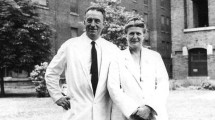Abstract
Procedures for preventing contamination in primary cell cultures must be carefully defined and strictly followed in order to obtain healthy cells. Protocols have been developed and refined in our laboratory for establishing primary cultures of muscle and fat stem cells without contamination from a variety of animals. Contamination of cell cultures is not only frustrating, but is also very expensive both in time and loss of materials. Through the consistent use of proper aseptic techniques, most instances of contamination may be avoided. We suggest that the basic principles detailed here will find wide applicability in the culturing of primary cells without contamination from many different types of animals and tissues.
Similar content being viewed by others
References
Adams RLP (1980). Cell culture for biochemists (Laboratory techniques in biochemistry and molecular biology, vol 8). Amsterdam, The Netherlands: Elsevier/North-Holland Biomedical Press.
Baker (1995). The Baker Company Catalogue. Sanford, ME: The Baker Company.
Corning (1981). General procedures for primary cell culture. Corning Incorporated: TC-14.
Corning (1987). General procedures for the cell culture laboratory. Corning Incorporated: TC-CGW-4A.
Corning (1989). General guide for identifying and correcting common cell culture growth and attachment problems. Corning Incorporated: TC-CI-27.
Dodson MV, McFarland DC, Martin EL, Brannon MA (1986). Isolation of satellite cells from ovine skeletal muscles. J of Tissue Cult Meth 10: 233-237.
Dodson MV, Martin EL, Brannon MA, Mathison BA, McFarland DC (1987). Optimization of bovine satellite cell-derived myotube formation in vitro. Tissue and Cell 19: 159-166.
Dodson MV, Mathison BA, Brannon MA, Martin EL, McFarland DC (1988). Comparison of ovine and rat muscle-derived satellite cells: Response to insulin. Tissue and Cell 20: 909-918.
Dodson MV, Mathison BA, Mathison BD (1990). Effects of medium and substratum on ovine satellite cell attachment, proliferation and differentiation in vitro. Cell Diff and Dev 29(1): 59-66.
Dodson MV, Vierck JL, Hossner KL, Byrne K and McNamara J (1997). The development and utility of a defined muscle and fat co-culture system. Tissue and Cell 29: 517-524.
Douglas WHJ, Dell'Orco RT (1979). Physical aspects of a tissue culture laboratory. In: Jakoby WB, Pastan IH (eds), Methods in Enzymology, vol. LVIII-cell culture, pp 3-18. New York: Academic Press.
Erickson S, Vierck J, Calkins D, Welter C, Krabbenhoft L, Byrne K, Greene E, Dodson MV (1998). Fusion of equine myogenic satellite cell strains in vitro. Oregon Sci J 14: 10-14.
Fisher Scientific Catalog (1998-99). Pittsburgh, PA: Fisher Scientific Company.
Freshney RI (1986). Introduction: Principles of sterile technique and cell propagation. In: Freshney RI (ed), Animal cell culture: A practical approach, pp 1-11. Oxford: IRL Press Limited.
Freshney RI (1994). Culture of animal cells. New York: Wiley-Liss.
GibcoBRL Products and Reference Guide (2000-2001). Grand Island, NY: Life Technologies.
Greene E, Raub R, Krabbenhoft L, Brannon B, Sullivan J, Hossner K, Dodson MV (1995). Initial observations on the growth factor regulation of equine satellite cells in vitro. Basic Appl Myol 5(1): 22-27.
Jeffrey JS (1997). Sanitation-Disinfection Basics. University of California: Cooperative Extension Service.
Knecht CD, Allen AR, Williams DJ, Johnson JH (1981). Fundamental Techniques in Veterinary Surgery. Philadelphia: W.B. Saunders Company.
McGarrity GJ (1979). Detection of contamination. In: Jakoby WB, Pastan IH (eds), Methods in enzymology, vol. LVIII-cell culture, pp 18-29. New York: Academic Press.
Mathison BD, Mathison BA, McNamara JP, Dodson MV (1989). IGF receptor analyses of satellite cellderived myotubes from two lines of Targhee rams selected for growth rate. Domest Anim Endocrin 6(3): 191-201.
Millipore Laboratory Catalogue, US Version (1997-98). Pittsburgh, PA: Fisher Scientific.
Molnar GR, Dodson MV (1992). Characterization of ovine semimembranosus muscle and associated satellite cells: Expression of fast and slow myosin heavy chain isoforms. Basic Appl Myol 2(3): 183-190.
Molnar GR, Dodson MV (1993). Satellite cells isolated from sheep muscle are heterogeneous. Basic Appl Myol 3(3): 173-180.
Nuaire (1996). Operation and Maintenance Manual-40 Labgard Laminar Flow Biological Safety Cabinet. Plymouth, MN: Nuaire, Inc.
Nuaire (1998). Operation and Maintenance Manual-Water-Jacketed US Autoflow Automatic CO2 Incubator. Plymouth, MN: Nuaire, Inc.
Perkins JJ (1969). Principles and methods of sterilization in health sciences. Illinois: Charles C. Thomas.
Powell Rl, Dodson MV and Cloud JG (1989). Cultivation and differentiation of satellite cells from skeletal muscle of the rainbow trout Salmo gairdneri. J Exptl Zool 250(3): 333-338.
Precision (1994). Installation and operation instructions for general purpose water baths. Chicago, IL: Precision Scientific, Inc.
Sigma (1999). Biochemicals and reagents for life science research. St. Louis, MO: Sigma-Aldrich Co.
Venkateswaran V, Brackett EJ, Vierck J, Cloud J, Dodson MV (1995). Substratum is an important determinant in growth factor regulation of troutderived satellite cells. Basic Appl Myol 5(3): 297-304.
Vierck J, McNamara J, Hossner K, Dodson MV (1995). Characterization of ovine skeletal muscle satellite cell strains in a defined medium formulated to enhance differentiation: Fusion and the IGF-I system. Basic Appl Myol 5(1): 12-21.
Vierck JL, McNamara JP, Dodson MV (1996a). Two alternative procedures to isolate adipofibroblasts from sheep skeletal muscle. Meth in Cell Sci 18(4): 309-314.
Vierck J, McNamara JP, Dodson MV (1996b). Proliferation and differentiation of progeny of ovine unilocular fat cells (adipofibroblasts). In Vitro Cell Dev Biol 32(10): 564-572.
Rights and permissions
About this article
Cite this article
Vierck, J.L., Byrne, K., Mir, P.S. et al. Ten commandments for preventing contamination of primary cell cultures. Methods Cell Sci 22, 33–41 (2000). https://doi.org/10.1023/A:1009826012986
Issue Date:
DOI: https://doi.org/10.1023/A:1009826012986




